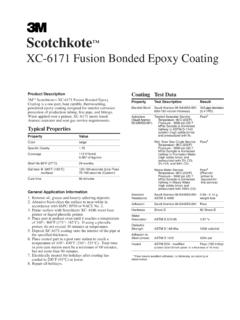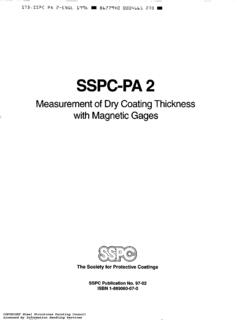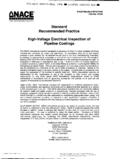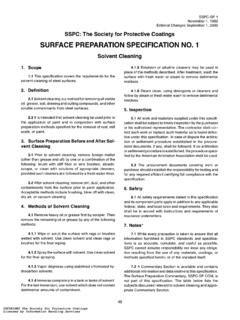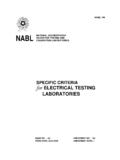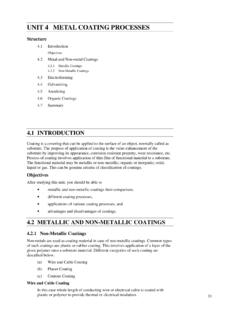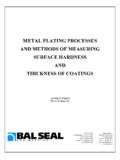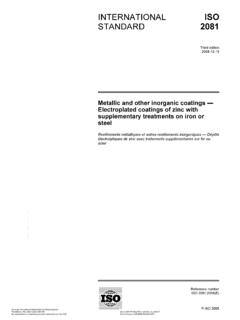Transcription of SSPC-SP 6/NACE NO. 3 - Reli Sleeve
1 SSPC-SP GINACE NO. 3 September 1, 2000 Joint Surface Preparation Standard SSPC-SP 6/NACE NO. 3 Commercial Blast Cleaning This sspc : The Society for Protective Coatings and NACE International standard represents a consensus of those individual members who have reviewed this docu- ment, its scope and provisions. Its acceptance does not in any respect preclude anyone, having adopted the standard or not, from manufacturing, marketing, purchasing, or using products, processes, or procedures not in conformance with this standard. Nothing contained in this standard is to be construed as granting any right, by implication or other- wise, to manufacture, sell, or use in connection with any method, apparatus, or product covered by Letters Patent, or as indemnifying or protecting anyone against liability for infringement of Letters Patent. This standard represents minimum requirements and should in no way be interpreted as a restriction on the use of better procedures or materials.
2 Neither is this standard intended to apply in all cases relating to the subject. Unpredictable circumstances may negate the usefulness of this standard in specific instances. sspc and NACE assume no responsibility for the interpre- tation or use of this standard by other parties and accept responsibility for only those official interpretations issued by sspc or NACE in accordance with their respective govern- ing procedures and policies, which preclude the issuance of interpretations by individual volunteers. Users of this standard are responsible for reviewing appropriate health, safety, and regulatory documents and for determining their applicability in relation to this standard prior to its use. This SSPCINACE standard may not neces- sarily address all potential health and safety problems or environmental hazards associated with the use of materi- als, equipment and/or operations detailed or referred to within this standard. Users of this standard are also respon- sible for establishing appropriate health, safety, and envi- ronmental protection practices, in consultation with appro- priate regulatory authorities, if necessary, to achieve com- pliance with any existing applicable regulatory require- ments prior to the use of this standard.
3 CAUTIONARY NOTICE: sspc /NACE standards are subject to periodic review and may be revised or withdrawn at any time without prior notice. sspc and NACE require that action be taken to reaffirm, revise, or withdraw this standard no later than five years from the date of initial publication. The user is cautioned to obtain the latest edition. Purchasers may receive current information on all standards and other publications by contacting the organi- zations at the addresses below: ONACE International Box 21 8340 Houston, TX 7721 8-8340 (telephone +1 2811228-6200) OSSPC: The Society for Protective Coatings 40 24th Street, Sixth Floor Pittsburgh, PA 15222 (telephone +1 41 2/281-2321) Foreword This joint standard covers the use of blast cleaning abrasives to achieve a defined degree of cleaning of steel surfaces prior to the application of a protective coating or lining system. This standard is intended for use by coating or lining specifiers, applicators, inspectors, or others whose responsibility it may be to define a standard degree of surface cleanliness.
4 The focus of this standard is commercial blast cleaning. White metal blast cleaning, near-white blast cleaning, indus- trial blast cleaning, and brush-off blast cleaning are ad- dressed in separate standards. Commercial blast cleaning provides a greater degree of cleaning than industrial blast cleaning ( SSPC-SP 14/ NACE No. 8), but less than near-white blast cleaning ( sspc - SP lO/NACE No. 2). Commercial blast cleaning is used when the objective is to remove all visible oil, grease, dust, dirt, mill scale, rust, coating, oxides, corrosion products and other foreign mat- ter, leaving staining or shadows on no more than 33 percent of each unit area of surface as described in Section The difference between a commercial blast and a near- white blast is in the amount of staining permitted to remain on the surface. Commercial blast allows stains or shadows on 33 percent of each unit area of surface. Near-white blast allows staining or shadows on only 5 percent of each unit area.
5 The difference between a commercial blast and an industrial blast is that a commercial blast removes all visible oil, grease, dust, dirt, mill scale, rust, coating, oxides, corro- sion products and other foreign matter from all surfaces and allows stains to remain on 33 percent of each unit area of surface, while industrial blast allows defined mill scale, coating, and rust to remain on less than 10 percent of the surface and allows defined stains to remain on all surfaces. 60 COPYRIGHT The Society for Protective CoatingsLicensed by Information Handling ServicesCOPYRIGHT The Society for Protective CoatingsLicensed by Information Handling ServicesSSPC-SP GINACE NO. 3 September 1, 2000 This joint standard was prepared by the SSPCINACE Task Group A on Surface Preparation by Abrasive Blast Cleaning. This joint Task Group includes members of both the sspc Surface Preparation Committee and the NACE Unit Committee T-6G on Surface Preparation. 1. General This joint standard covers the requirements for commercial blast cleaning of unpainted or painted steel surfaces by the use of abrasives.
6 These requirements include the end condition of the surface and materials and procedures necessary to achieve and verify the end condi- tion. The mandatory requirements are described in Sec- Section 1 General Section 2 Definition Section 3 References Section 4 Section 5 Section 6 Blast Cleaning Abrasives Section 7 Section 8 Inspection Section 9 tions 1 to 9 as follows: Procedures Before Blast Cleaning Blast Cleaning Methods and Operation Procedures Following Blast Cleaning and Immediately Prior to Coating Safety and Environmental Requirements NOTE: Section 1 O, Comments and Appendix A, Explana- tory Notes are not mandatory requirements of this stan- dard. 2. Definition A commercial blast cleaned surface, when viewed without magnification, shall be free of all visible oil, grease, dust, dirt, mill scale, rust, coating, oxides, corrosion prod- ucts, and other foreign matter, except for staining as noted in Section Random staining shall be limited to no more than 33 percent of each unit area of surface as defined in Section , and may consist of light shadows, slight streaks, or minor discolorations caused by stains of rust, stains of mill scale, or stains of previously applied coating.
7 Acceptable variations in appearance that do not affect surface cleanliness as defined in Section include variations caused by type of steel, original surface condi- tion, thickness of the steel, weld metal, mill or fabrication marks, heat treating, heat affected zones, blasting abra- sives, and differences due to blasting technique. When a coating is specified, the surface shall be roughened to a degree suitable for the specified coating system. Immediately prior to coating application, the entire surface shall comply with the degree of cleaning specified herein. Unit area for determinations shall be approximately 5776 mm2 (9 in2) ( .e., a square 76 x 76 mm [3 in x 3 in]). sspc -VIS 1-89 may be specified to supplement the written definition. In any dispute, the written standards shall take precedence over visual standards and comparators. Additional information on visual standards and comparators is available in Section of Appendix A. 3.
8 References The documents referenced in this standard are listed in Section The latest issue, revision, or amendment of the referenced standards in effect on the date of invitation to bid shall govern unless otherwise specified. If there is a conflict between the requirements of any of the cited reference standards and this standard, the requirements of this standard shall prevail. sspc : THE SOCIETY FOR PROTECTIVE COAT- INGS STANDARDS: AB 1 AB 2 AB 3 PA Guide 3 A Guide to Safety in Paint Application SP 1 Solvent Cleaning VIS 1-89 Visual Standard for Abrasive Blast Mineral and Slag Abrasives Cleanliness of Recycled Ferrous Metallic Abrasives Newly Manufactured or Re-Manufactured Steel Abrasives Cleaned Steel 4. Procedures Before Blast Cleaning Before blast cleaning, visible deposits of oil, grease, or other contaminants shall be removed in accordance with SSPC-SP 1 or other agreed upon methods. Before blast cleaning, surface imperfections such as sharp fins, sharp edges, weld spatter, or burning slag should be removed from the surface to the extent required by the procurement documents (project specification).
9 Ad- ditional information on surface imperfections is available in Section of Appendix A. If a visual standard or comparator is specified to supplement the written standard, the condition of the steel prior to blast cleaning should be determined before the blasting commences. Additional information on visual stan- dards and comparators is available in Section of Appen- dix A. 61 COPYRIGHT The Society for Protective CoatingsLicensed by Information Handling ServicesCOPYRIGHT The Society for Protective CoatingsLicensed by Information Handling ServicesSSPC-SP GINACE NO. 3 September 1, 2000 5. Blast Cleaning Methods and Operation Clean, dry compressed air shall be used for nozzle blasting. Moisture separators, oil separators, traps, or other equipment may be necessary to achieve this requirement. Any of the following methods of surface preparation may be used to achieve a commercial blast cleaned surface: Dry abrasive blasting using compressed air, blast nozzles, and abrasive.
10 Dry abrasive blasting using a closed-cycle, recir- culating abrasive system with compressed air, blast nozzle, and abrasive, with or without vacuum for dust and abrasive recovery. Dry abrasive blasting using a closed cycle, recir- culating abrasive system with centrifugal wheels and abra- sive. Other methods of surface preparation (such as wet abrasive blasting) may be used to achieve a commercial blast cleaned surface by mutual agreement between those responsible for performing the work and those responsible for establishing the requirements. NOTE: Information on the use of inhibitors to prevent the formation of rust imme- diately after wet blast cleaning is contained in Section of Appendix A. 6. Blast Cleaning Abrasives The selection of abrasive size and type shall be based on the type, grade, and surface condition of the steel to be cleaned, type of blast cleaning system employed, the finished surface to be produced (cleanliness and rough- ness), and whether the abrasive will be recycled.
